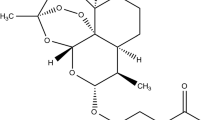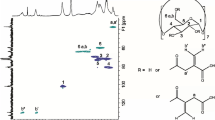Abstract
The inclusion complex of cucurbit[7]uril (CB7) and albendazole (ABZ) in solid state was prepared by freeze-drying. The formation of a host–guest complex was confirmed by microanalysis, 1H-nuclear magnetic resonance spectroscopy, and fourier transformed-infrared spectroscopy (FT-IR) techniques. The shifts in the NMR peaks supported the encapsulation from the propylthio and not the carbamate site, in agreement with the previously reported results in solution. The N2 adsorption–desorption isotherms indicated no change in the calculated surface area or the pore size distribution for the unbound and CB7-bound ABZ solid drugs. Freeze-drying produced a system with a higher degree of amorphisation as confirmed by the X-ray powder diffraction (XRD) technique. Thermal analysis of the drug-loaded CB7 by using differential scanning calorimetry and thermogravimetry demonstrated the possibility of dehydration at temperature 100 °C beyond the melting point of unbound ABZ since no melting of the samples was observed until the CB7 itself begins to decompose around 300 °C. Putting it all together, the results supported that CB7 imparts significant thermal/physical stability on the ABZ drug in the solid state.








Similar content being viewed by others
References
Chieng N, Rades T, Aaltonen J. An overview of recent studies on the analysis of pharmaceutical polymorphs. J Pharm Biom Anal. 2011;55(4):618–44.
Brittain HG. Polymorphism in pharmaceutical solids. 2nd ed. New York: Informa Healthcare; 2009.
Yoshioka S, Stella VJ. Stability of drugs and dosage forms. Hingham: Kluwer Academic Publisher; 2000.
Freeman WA, Mock WL, Shih NY. Cucurbituril. J Am Chem Soc. 1981;103(24):7367–8.
Lagona J, Mukhopadhyay P, Chakrabarti S, Isaacs L. The cucurbit[n]uril family. Angew Chem Int Ed. 2005;44(31):4844–70.
Masson E, Ling X, Joseph R, Kyeremeh-Mensah L, Lu X. Cucurbituril chemistry: a tale of supramolecular success. RSC Adv 2012. doi:10.1039/C1RA00768H.
Walker S, Oun R, McInnes FJ, Wheate NJ. The potential of cucurbit[n]urils in drug delivery. Isr J Chem. 2011;51(5–6):616–24.
Ghosh I, Nau WM. The strategic use of supramolecular pK a shifts to enhance the bioavailability of drugs. Adv Drug Deliv Rev. 2012. doi:10.1016/j.addr.2012.01.015.
Shchepotina E, Pashkina E, Yakushenko E, Kozlov V. Cucurbiturils as containers for medicinal compounds. Nanotechnol Russ. 2011;6(11):773–9.
Moghaddam S, Yang C, Rekharsky M, Ko YH, Kim K, Inoue Y, et al. New ultrahigh affinity host-guest complexes of cucurbit[7]uril with bicyclo[2.2.2]octane and adamantane guests: thermodynamic analysis and evaluation of M2 affinity calculations. J Am Chem Soc. 2011;133(10):3570–81.
Saleh N, Koner AL, Nau WM. Activation and stabilization of drugs by supramolecular pK a shifts: drug-delivery applications tailored for cucurbiturils. Angew Chem Int Ed. 2008;47(29):5398–401.
Lee JW, Samal S, Selvapalam N, Kim HJ, Kim K. Cucurbituril homologues and derivatives: new opportunities in supramolecular chemistry. Acc Chem Res. 2003;36(8):621–30.
Kim J, Jung IS, Kim SY, Lee E, Kang JK, Sakamoto S, et al. New cucurbituril homologues: syntheses, isolation, characterization, and X-ray crystal structures of cucurbit[n]uril (n = 5, 7, and 8). J Am Chem Soc. 2000;122(3):540–1.
Saleh N, Meetani M, Al-Kaabi L, Ghosh I, Nau WM. Effects of cucurbiturils on tropicamide and potential applications in ocular drug delivery. Supramol Chem. 2011;23(9):654–61.
Koner AL, Ghosh I, Saleh N, Nau WM. Supramolecular encapsulation of benzimidazole-derived drugs by cucurbit[7]uril. Can J Chem. 2011;89(2):139–47.
Uzunova VD, Cullinane C, Brix K, Nau WM, Day AI. Toxicity of cucurbit[7]uril and cucurbit[8]uril: an exploratory in vitro and in vivo study. Org Biomol Chem. 2010;8(9):2037–42.
Jeon YJ, Kim SY, Ko YH, Sakamoto S, Yamaguchi K, Kim K. Novel molecular drug carrier: encapsulation of oxaliplatin in cucurbit[7]uril and its effects on stability and reactivity of the drug. Org Biomol Chem. 2005;3(11):2122–5.
Hettiarachchi G, Nguyen D, Wu J, Lucas D, Ma D, Isaacs L, et al. Toxicology and drug delivery by cucurbit[n]uril type molecular containers. PLoS ONE. 2010;5(5):e10514.
Bardelang D, Udachin KA, Leek DM, Margeson JC, Chan G, Ratcliffe CI, et al. Cucurbit[n]urils (n = 5–8): a comprehensive solid state study. Cryst Growth Des. 2011;11(12):5598–614.
Isaacs L. The mechanism of cucurbituril formation. Isr J Chem. 2011;51(5–6):578–91.
Kim E, Kim D, Jung H, Lee J, Paul S, Selvapalam N, et al. Facile, template-free synthesis of stimuli-responsive polymer nanocapsules for targeted drug delivery. Angew Chem Int Ed. 2010;49(26):4405–8.
Horton J. Albendazole: a review of anthelmintic efficacy and safety in humans. Parasitology. 2000;121:S113–32.
Hao D, Rizzo JD, Stringer S, Moore RV, Marty J, Dexter DL, et al. Preclinical antitumor activity and pharmacokinetics of methyl-2-benzimidazolecarbamate (FB642). Invest New Drugs. 2002;20(3):261–70.
Pourgholami MH, Szwajcer M, Chin M, Liauw W, Seef J, Galettis P, et al. Phase I clinical trial to determine maximum tolerated dose of oral albendazole in patients with advanced cancer. Cancer Chemother Pharmacol. 2010;65(3):597–605.
Zhao YJ, Buck DP, Morris DL, Pourgholami MH, Day AI, Collins JG. Solubilisation and cytotoxicity of albendazole encapsulated in cucurbit[n]uril. Org Biomol Chem. 2008;6(24):4509–15.
Zhao YJ, Pourgholami MH, Morris DL, Collins JG, Day AI. Enhanced cytotoxicity of benzimidazole carbamate derivatives and solubilisation by encapsulation in cucurbit[n]uril. Org Biomol Chem. 2010;8(14):3328–37.
Pranzo MB, Cruickshank D, Coruzzi M, Caira MR, Bettini R. Enantiotropically related albendazole polymorphs. J Pharm Sci. 2010;99(9):3731–42.
Castillo JA, Palomo-Canales J, Garcia JJ, Lastres JL, Bolas F, Torrado JJ. Preparation and characterization of albendazole β-cyclodextrin complexes. Drug Dev Ind Pharm. 1999;25(12):1241–8.
Moriwaki C, Costa GL, Ferracini CN, de Moraes FF, Zanin GM, Pineda EAG, et al. Enhancement of solubility of albendazole by complexation with β-cyclodextrin. Braz J Chem Eng. 2008;25(2):255–67.
Wheate NJ, Vora V, Anthony NG, McInnes FJ. Host-guest complexes of the antituberculosis drugs pyrazinamide and isoniazid with cucurbit[7]uril. J Incl Phenom Macro Chem. 2010;68(3–4):359–67.
McInnes FJ, Anthony NG, Kennedy AR, Wheate NJ. Solid state stabilisation of the orally delivered drugs atenolol, glibenclamide, memantine and paracetamol through their complexation with cucurbit[7]uril. Org Biomol Chem. 2010;8(4):765–73.
Kennedy AR, Florence AJ, McInnes FJ, Wheate NJ. A chemical preformulation study of a host-guest complex of cucurbit[7]uril and a multinuclear platinum agent for enhanced anticancer drug delivery. Dalton Trans. 2009;37:7695–700.
Renu C, Poonam A, Sushma G, Singh JD. Complexation of nevirapine with β-cyclodextrins in the presence and absence of Tween 80: characterization, thermodynamic parameters, and permeability flux. J Therm Anal Calorim. 2011;105(3):1049–59.
Soares-Sobrinho JL, Soares MFD, Rolim-Neto PJ, Torres-Labandeira JJ. Physicochemical study of solid-state benznidazole-cyclodextrin complexes. J Therm Anal Calorim. 2011;106(2):319–25.
Giron D. Applications of thermal analysis and coupled techniques in pharmaceutical industry. J Therm Anal Calorim. 2002;68(2):335–57.
Gad SC. Pharmaceutical manufacturing handbook: production and processes. Wiley; 2008
Brunauer S, Emmett PH, Teller E. Adsorption of gases in multimolecular layers. J Am Chem Soc. 1938;60:309–19.
Lim S, Kim H, Selvapalam N, Kim KJ, Cho SJ, Seo G, et al. Cucurbit[6]uril: Organic molecular porous material with permanent porosity, exceptional stability, and acetylene sorption properties. Angew Chem Int Ed. 2008;47(18):3352–5.
Germain P, Letoffe JM, Merlin MP, Buschmann HJ. Thermal behaviour of hydrated and anhydrous cucurbituril - A DSC, TG and calorimetric study in temperature range from 100 to 800 K. Thermochim Acta. 1998;315(2):87–92.
Bardelang D, Udachin KA, Leek DM, Ripmeester JA. Highly symmetric columnar channels in metal-free cucurbit[n]uril hydrate crystals (n = 6, 8). CrystEngComm. 2007;9(11):973–5.
Bardelang D, Udachin KA, Anedda R, Moudrakovski I, Leek DM, Ripmeester JA, et al. Single-crystal to single-crystal phase transition of cucurbit[5]uril hydrochloride hydrates: large water-filled channels transforming to layers of unusual stability. Chem Commun. 2008;40:4927–9.
Nau WM, Florea M, Assaf KI. Deep inside cucurbiturils: physical properties and volume of their inner cavity determine the hydrophobic driving forces for host-guest complexation. Isr J Chem. 2011;51:559.
Alanazi FK, El-Badry M, Mahtous OA, Al-Sarra IA. Improvement of albendazole dissolution by preparing microparticles using spray-drying technique. Allemand. 2007;75(2):63–79.
Hwang I, Jeon WS, Kim HJ, Kim D, Kim H, Selvapalam N, et al. Cucurbit[7]uril: a simple macrocyclic, pH-triggered hydrogelator exhibiting guest-induced stimuli-responsive behavior. Angew Chem Int Ed. 2007;46(1–2):210–3.
Huang XL, Tan YB, Zhou QF, Wang YX. Fabrication of cucurbit[6]uril mediated alginate physical hydrogel beads and their application as a drug carriers. E Polym. 2008;095.
Barbato F, La Rotonda MI, Miro A, Morrica P, Quaglia F. Inclusion complexation of carbaryl and β-cyclodextrin in solution and in the solid state. J Incl Phenom Macro Chem. 2000;38(1–4):423–33.
Acknowledgements
N.S. would like to acknowledge Research Affairs at the United Arab Emirates University for their financial support of this project under grant number NRF/21S041.
Author information
Authors and Affiliations
Corresponding author
Rights and permissions
About this article
Cite this article
Saleh, N., Khaleel, A., Al-Dmour, H. et al. Host–guest complexes of cucurbit[7]uril with albendazole in solid state. J Therm Anal Calorim 111, 385–392 (2013). https://doi.org/10.1007/s10973-012-2376-5
Received:
Accepted:
Published:
Issue Date:
DOI: https://doi.org/10.1007/s10973-012-2376-5




